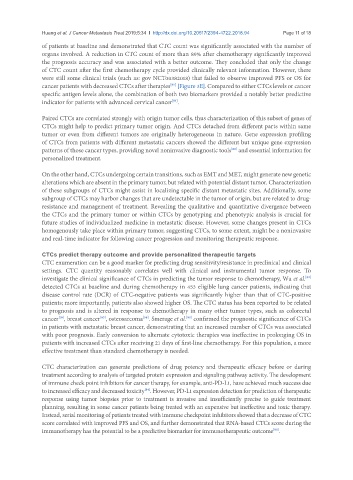Page 84 - Read Online
P. 84
Huang et al. J Cancer Metastasis Treat 2019;5:34 I http://dx.doi.org/10.20517/2394-4722.2018.94 Page 11 of 18
of patients at baseline and demonstrated that CTC count was significantly associated with the number of
organs involved. A reduction in CTC count of more than 89% after chemotherapy significantly improved
the prognosis accuracy and was associated with a better outcome. They concluded that only the change
of CTC count after the first chemotherapy cycle provided clinically relevant information. However, there
were still some clinical trials (such as: gov NCT00382018) that failed to observe improved PFS or OS for
cancer patients with decreased CTCs after therapies [Figure 3E]. Compared to either CTCs levels or cancer
[80]
specific antigen levels alone, the combination of both two biomarkers provided a notably better predictive
indicator for patients with advanced cervical cancer .
[81]
Paired CTCs are correlated strongly with origin tumor cells, thus characterization of this subset of genes of
CTCs might help to predict primary tumor origin. And CTCs detached from different parts within same
tumor or even from different tumors are originally heterogeneous in nature. Gene expression profiling
of CTCs from patients with different metastatic cancers showed the different but unique gene expression
patterns of those cancer types, providing novel noninvasive diagnostic tools and essential information for
[68]
personalized treatment.
On the other hand, CTCs undergoing certain transitions, such as EMT and MET, might generate new genetic
alterations which are absent in the primary tumor, but related with potential distant tumor. Characterization
of these subgroups of CTCs might assist in localizing specific distant metastatic sites. Additionally, some
subgroup of CTCs may harbor changes that are undetectable in the tumor of origin, but are related to drug-
resistance and management of treatment. Revealing the qualitative and quantitative divergence between
the CTCs and the primary tumor or within CTCs by genotyping and phenotypic analysis is crucial for
future studies of individualized medicine in metastatic disease. However, some changes present in CTCs
homogenously take place within primary tumor, suggesting CTCs, to some extent, might be a noninvasive
and real-time indicator for following cancer progression and monitoring therapeutic response.
CTCs predict therapy outcome and provide personalized therapeutic targets
CTC enumeration can be a good marker for predicting drug sensitivity/resistance in preclinical and clinical
settings. CTC quantity reasonably correlates well with clinical and instrumental tumor response. To
investigate the clinical significance of CTCs in predicting the tumor response to chemotherapy, Wu et al.
[82]
detected CTCs at baseline and during chemotherapy in 453 eligible lung cancer patients, indicating that
disease control rate (DCR) of CTC-negative patients was significantly higher than that of CTC-positive
patients; more importantly, patients also showed higher OS. The CTC status has been reported to be related
to prognosis and is altered in response to chemotherapy in many other tumor types, such as colorectal
cancer , breast cancer , osteosarcoma . Smerage et al. confirmed the prognostic significance of CTCs
[80]
[58]
[10]
[83]
in patients with metastatic breast cancer, demonstrating that an increased number of CTCs was associated
with poor prognosis. Early conversion to alternate cytotoxic therapies was ineffective in prolonging OS in
patients with increased CTCs after receiving 21 days of first-line chemotherapy. For this population, a more
effective treatment than standard chemotherapy is needed.
CTC characterization can generate predictions of drug potency and therapeutic efficacy before or during
treatment according to analysis of targeted protein expression and signaling pathway activity. The development
of immune check point inhibitors for cancer therapy, for example, anti-PD-L1, have achieved much success due
to increased efficacy and decreased toxicity . However, PD-L1 expression detection for prediction of therapeutic
[84]
response using tumor biopsies prior to treatment is invasive and insufficiently precise to guide treatment
planning, resulting in some cancer patients being treated with an expensive but ineffective and toxic therapy.
Instead, serial monitoring of patients treated with immune checkpoint inhibitors showed that a decrease of CTC
score correlated with improved PFS and OS, and further demonstrated that RNA-based CTCs score during the
immunotherapy has the potential to be a predictive biomarker for immunotherapeutic outcome .
[85]

